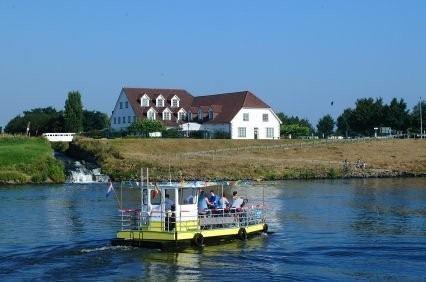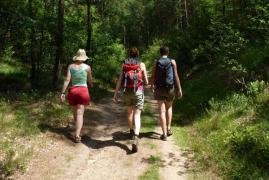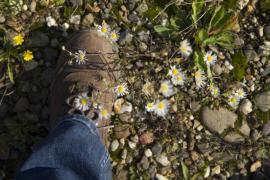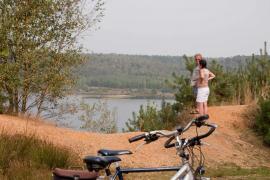Stevensweert
Stevensweert is a historic fortified settlement located on an island between two streams of the Meuse. This fortification was founded by the Spanish in 1633 during the Eighty Years’ War. The street planning is reminiscent of the times of fortifications - the streets run towards the village centre like the spokes of a wheel. For residents and visitors to Stevensweert alike, parts of the rammed-earth walls with a wide moat were reconstructed to show how the fortifications would have looked in the past.
This is a spectacular area where you can experience history, unwind, and enjoy wonderful walks. The lakes around the Meuse are a recreational area for sailing boats and motor boats, surfers, and swimmers and have several recreational beaches and marinas. You can also book boat tours through this beautiful water district departing from Stevensweert. For walkers and cyclists a network of ferries connects Thorn, Wessem, and Stevensweert to each other and to Ophoven-Kinrooi in Belgium.
Junction system for cycling routes
Discover RivierPark Maasvallei on the bicycle. The practical junction network of cycling routes allows you to plan your route with the relevant numbers before your trip. When you embark on your cycling trip, all you need to do is follow the numbers that you have selected. The distances between the junctions are also clearly marked allowing you to plan routes between the junctions. The Dutch cycling routes junctions connect directly with those in Belgium. The maps for the network are available at all South Limburg tourist information offices (VVV Zuid-Limburg). You can also order the map of the cycling routes junctions at our online shop.
The Meuse lakes in Maasgouw
The villages that make up Maasgouw municipality have a rich history and a pastoral character. The village of Thorn is known as the white village. Ohé en Laak and the fortified settlement of Stevensweert are known as ‘the island in the Meuse’. The urban character of the old village centre in Wessem and the charming villages of Heel, Beegden, and Linne make this municipality worth a visit. Maasbracht is the home base of commercial shipping and has the largest inland port of the Netherlands.
The lakes of the Meuse
The lakes of the Meuse in Maasgouw together form the largest water sports area of the Netherlands and are collectively known as the ‘Maasplassen’ (the lakes of the Meuse). The many lakes in this region make it a perfect location for water sports and other recreational activities on water. Click here to view the list of water activities in the lakes of the Meuse.
The white village of Thorn
The white village of Thorn is located in Maasgouw municipality. Thorn is a popular tourist destination partly because of its rich and interesting history that stretches back to the end of the tenth century. Throughout the ages, a small-scale principality flourished under the guidance of an abbess and twenty noble female monastics. This little state had its own justice system and currency. However, the French occupation in 1794 brought an end to this independence.
Cycling along the lakes of the Meuse in RivierPark Maasvallei
This cycle route winds along the southern lakes of the Meuse dotted with several beautiful villages and nature reserves. This route takes you to the white village of Thorn, Maaseik in Belgium, the island in the Meuse (which is home to the villages Ohé en Laak and Stevensweert), Maasbracht, and Wessem. This is a beautiful lakeside route that passes many of the most stunning locations of the region. From 1 May until 30 September the route can be shortened by taking a foot/bicycle ferry at Ohé en Laak (NL) and Ophoven (B). Click here to view an online map of the cycle route.
Ohé en Laak

Ohé en Laak, together with Stevensweert, is located on the Eiland in de Maas (literally island in the Meuse). The island is located in Central Limburg, west of the small town of Echt. Sand and gravel extraction activities around the island created several new lakes around the village. Throughout the years, the island has become known as a top destination for water sports with a small marina and many walking and cycling roots to explore. At Ohé en Laak you can take the ferry across the Meuse to Belgium. For more information about the ferries, click here.
Hompesche Molen
The Hompesche Molen tower mill in Stevensweert is a beautiful starting point from which to explore the northern part of RivierPark Maasvallei. Standing at 37 metres tall, the Hompesche Molen is the tallest grain mill in Limburg province with a total of six floors including the basement. This 300-year old mill is a national monument and was completely restored in 2015. At the base of the mill, Natuurmonumenten (the Society for the Preservation of Nature in the Netherlands) is going to create an information point that gives visitors the story of the cultural history of the mill and the environment. An OERRR nature playground for children is also being constructed (OERRR is a youth programme of the Society for the Preservation of Nature in the Netherlands that encourages children to discover nature and play outside). The miller will regularly set the mill to work and give tours about the mill and its history. Those who dare can climb up the mill and enjoy the panoramic views from the top. The mill has a brasserie where you can enjoy a bite to eat and something to drink.
Molenplas
The Molenplas lake lies near to the Hompesche Molen mill. This Meuse lake was created by the most recent gravel extraction activities. The natural environment has been able to flourish here under the management of Natuurmonumenten (the Society for the Preservation of Nature in the Netherlands). Unique plants such as Red Bartsia and sticklewort are in full bloom and the common tern, little ringed plovers, and the beaver call this area home.
A monument of trees
Several circles of trees have been placed along the Molenplas lake. The first tree monument can be spotted from the Hompesche Molen mill. This monument is made of the tree trunks of 2,000-year-old oaks that were covered and preserved by the gravel of the Meuse. These black tree stumps were uncovered during the gravel extraction activities that created the Molenplas lake. The trees have been placed here as a reflection of days gone by and stand here as a monument and point of reference.
Walking route with stepping stones
The Molenplas area is a place where you can enjoy off-trail walks. This means that you do not have to stay on the trails and that you are free to wander through the area. Dogs must be kept on a leash. A planned walking route around the Molenplas lake, takes you across the lake via the stepping stone bridge. You can also use the route app of Natuurmonumenten (the Society for the Preservation of Nature in the Netherlands).
Koningssteen
Koningssteen is one of the oldest rewilding areas along the Meuse. This was once an island of gravel in the Meuse but has been transformed into a 50 hectare peninsula with a beautiful natural environment. The Konik horses and Galloway cattle that have been released here by the Society for the Preservation of Nature in the Netherlands can be seen peacefully grazing all-year round. The presence of the herds creates a stunning mosaic landscape of open fields, wild thickets, and willow forests. During spring, Koningssteen is transformed into a sea of flowers. You can freely wander off-trail on this peninsula. Koningssteen is located on the border between Belgium and the Netherlands and you will see many boundary markers in this area. The entrance to Koningssteen nature reserve is at the Grote Heggeplas lake recreational beach in Thorn.




